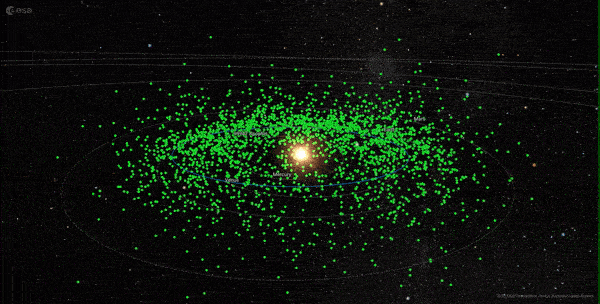
On February 14, 2046, a small but still decent-sized asteroid will almost certainly not hit Earth.
That’s generally the way to bet about any space rock, but if you only read the headlines last week when a new near-Earth asteroid was discovered, you might get a different impression. The basic gist of many of them was, ‘NASA says an asteroid could hit Earth on Valentine’s Day 2046.’
That “could” carried a lot of weight, though. If you read deeper, the Chicken Littling calmed down a bit, and you’d find the odds of impact are low and likely to get lower. But these articles never explain how this likely lowering works, showing just why the odds tend to drop. Worse, we see this sort of “OMG” turning to a “never mind” reaction every time a new asteroid is discovered with a non-zero chance of impact at some point in the nebulous future.
So let’s take a deep breath, look at the science, and keep in mind the immortal advice of The Hitchhiker’s Guide to the Universe: Don’t Panic.
The asteroid in question here is called 2023 DW, discovered on February 26, 2023 by the MAP Project using a telescope in the high desert of Chile. Calculations based on these initial observations, and some a few days later, determined that 2023 DW was roughly 50 meters across — much larger than the 2013 Chelyabinsk asteroid and more like the one that exploded in an airburst over the Tunguska region of Siberia in 1908 — and that its orbit might bring it very close to Earth.
Very close. The calculations showed a 1 in 770 chance of 2023 DW whacking into our planet on February 14, 2046. In fact, the asteroid earned a rating of 1 on the Torino impact hazard scale, which measures the danger of a potential impact. A rating of 0 means no impact, and 10 means a certain impact from a rock big enough to cause global disaster. The vast majority of new asteroids get a rating of 0, but even a 1 means an impact can’t be completely ruled out, and that some havoc could yet be wreaked.
Hence the headlines. But how worried should we be?
Having been through this situation many, many times, my answer is easy: See the Douglas Adams quote above. First of all, a 1 in 770 chance of impact is better thought of as a 99.87% chance it’ll miss. And, almost inevitably, over time those impact odds will drop even more.
This moment of astronomical de-escalation is brought to you courtesy of how we discover asteroids, how we characterize their orbits, and, most importantly, how these numbers change over time.
Dedicated telescopes worldwide search for asteroids every clear night, sweeping broad swaths of the sky. The stars don’t move from image to image, but asteroids do. Automated software looks for moving blips of light, checks them against possible false positives like subatomic particles from space zapping the detector, oversensitive pixels, and the like. If an object moves in a predictable way across the images, the software alerts astronomers that a potential space rock has been found. Most turn out to be one of the known asteroids — which number well over a million — but dozens of new ones are found every night.
Astronomers can then measure the position of the asteroid over time to calculate the basic shape of its orbit using mathematics pioneered by Johannes Kepler and generalized by Isaac Newton in the 17th century. This in turn allows astronomers to predict where the asteroid will be in the future, which is how they concluded that Earth and 2023 DW had the unfortunate possibility of being at the same place at the same time in 23 years.
But there’s an inherent uncertainty in these initial measurements due to the short baseline of initial observations. With such a limited time span of just a few days it’s difficult if not impossible to reliably determine the asteroid’s motion.
Think of it this way: Imagine you’re an outfielder in a baseball game. You’re watching the pitcher throw the ball, and the batter takes a mighty swing. CRACK! They hit the ball and it starts flying in your direction.
Now imagine that a split-second after you see the batter hit the ball, you close your eyes. Can you catch it?
Probably not. You didn’t have enough time to get a feel for the trajectory of the ball, so you don’t know where it’s heading, let alone be able to intercept it with your relatively tiny mitt. The longer you watch it, though, the better you know exactly where it is, and the better your chances of making the play.
The same is true for asteroids. Imagine a telescope sees one moving roughly due east in the sky over the course of a night. That small arc isn’t long enough to see if it’s also moving a little bit north or south; don’t forget space has depth, too, so it may be moving a little bit toward or away from you as well. Over time that small deviation from due east adds up, spreading ahead of the asteroid’s position like a fuzzy cone. A month from now it could be anywhere inside a large volume of space. The Earth too may be in that same volume, so an impact is possible.
However, the Earth is a small mitt in a vast empty outfield. The odds of an impact in these situations are low. You need more observations to beat down that uncertainty, and hone in on the true trajectory of the asteroid.
Here’s where statistics works in our favor. If at first the asteroid is predicted to get very near Earth, any change in that prediction due to later observations will more likely move the calculated path away from our fair planet. What initially were long odds become even longer over time.
And, cutting to the chase, that’s exactly what has happened with 2023 DW. The first observations had it passing extremely close to Earth, but only a few days later more observations were made that moved the potential path of the asteroid; the most likely trajectory now has it missing us by 4.5 million kilometers (more than ten times the distance to the Moon) in February 2046. It could pass as much as 8 million kilometers from us, and the minimum distance is now 2,00,000 kilometers—meaning it will indeed miss, and by a large amount. That calculated distance could easily grow as more observations are made—even in the short time it took to write this article and get it into print the numbers changed more in our favor.
And this is why I personally don’t fret over any newly discovered asteroid predicted to have some chance of hitting us years in the future. The safe bet is a clean miss.
Note too that just days after 2023 DW was discovered, a larger (roughly 50-meter) asteroid called 2023 DZ2 was found which will pass Earth by only 175,000 kilometers on March 25, 2023. For a short time there was a 1 in 430 chance of impact in 2026, but within days the odds dropped to 1 in 71,000 – a 99.9986% chance it’ll miss. 2023 DZ was swiftly dropped from the NASA/JPL Sentry watchlist of potentially dangerous asteroids.
I’ll go even farther and be happy for close misses: They help astronomers work out better methods for orbital calculations, the asteroid can be observed much more easily (and safely) than distant ones, and if it gets close enough it can even be pinged by radar, which can reveal its shape, rotation, rough composition, and far more precisely nail down its orbit.
Not to belabor the point, but Don’t Panic. Maybe even celebrate! We’re safe, and we get more science. I call that a good bet.
This is an opinion and analysis article, and the views expressed by the author or authors are not necessarily those of Scientific American.


